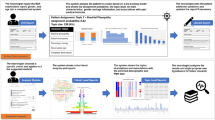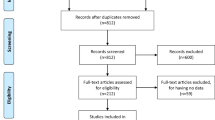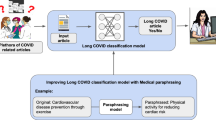Abstract
Background
Pediatric research is a diverse field that is constantly growing. Current machine learning advancements have prompted a technique termed text-mining. In text-mining, information is extracted from texts using algorithms. This technique can be applied to analyze trends and to investigate the dynamics in a research field. We aimed to use text-mining to provide a high-level analysis of pediatric literature over the past two decades.
Methods
We retrieved all available MEDLINE/PubMed annual data sets until December 31, 2018. Included studies were categorized into topics using text-mining.
Results
Two hundred and twenty-five journals were categorized as Pediatrics, Perinatology, and Child Health based on Scimago ranking for medicine journals. We included 201,141 pediatric papers published between 1999 and 2018. The most frequently cited publications were clinical guidelines and meta-analyses. We found that there is a shift in the trend of topics. Epidemiological studies are gaining more publications while other topics are relatively decreasing.
Conclusions
The topics in pediatric literature have shifted in the past two decades, reflecting changing trends in the field. Text-mining enables analysis of trends in publications and can serve as a high-level academic tool.
Impact
-
Text-mining enables analysis of trends in publications and can serve as a high-level academic tool.
-
This is the first study using text-mining techniques to analyze pediatric publications.
-
Our findings indicate that text-mining techniques enable better understanding of trends in publications and should be implemented when analyzing research.
Similar content being viewed by others
Introduction
Pediatrics is a field of large research diversity1 reflected by the origin of publications, a large number of topics, and a wide range of article types. In order to maintain your expertize as a pediatrician, you constantly need to keep updated regarding new knowledge.2,3 In 1998, Bergman presented a work analyzing the trends in pediatric publications.1 This work used manual analysis of pediatric research topics. However, the number of pediatric publications increased exponentially over the past decades making it impossible to manually summarize a topic.4
In text-mining, information is extracted from texts using computer algorithms.5 Text-mining can be applied to identify trends and to investigate the dynamics in a research field.4,6,7,8 Examples include anti-epileptic drug research,9 adolescent substance abuse,10 and Diatom research.9 The application of such algorithms has not been frequently used in pediatric research. In this work, we aimed to use text-mining to provide a high-level analysis of trends in pediatric literature over the past two decades.
Methods
Data set
The U.S. National Library of Medicine produces an annual version of MEDLINE/PubMed data. This data set is freely available to download.11 We retrieved all available MEDLINE/PubMed annual data sets until December 31, 2018.
We extracted the following data for each entry: PubMed unique article ID (PMID), title, publishing journal, abstract text, keywords (if any), and authors (including the first author affiliation, if available).
We retrieved the number of times each article was cited. For this purpose, we used a National Center for Biotechnology Information application.11 Data lock and citation retrieval was performed on May 1, 2019.
Data processing
Data processing and result visualization were written on Python (ver. 3.6.5, 64 bits).
For text-mining, punctuations and double spaces were removed. First author country was retrieved from the affiliation data of the first author.
Inclusion criteria
We included articles published in journals categorized as “Pediatrics, Perinatology, and Child Health” based on Scimago ranking for medicine journals.12 The time frame for article inclusion was the past 20 years (1/1/1999–31/12/2018). As the text-mining technique is dependent on the text in the abstract, we included only entries with abstracts >50 words.
Topic modeling
Included studies were categorized into topics using latent Dirichlet allocation (LDA).13 This algorithm is well documented and is commonly utilized for topic modeling. LDA splits the corpus into groups by grouping together documents with similar words. Each group is the most significant set of words used by the algorithm for the differentiation. We set the algorithm to output 200 groups of word sets. Manual allocation of topics to each set of words was performed by a domain expert (S.L.-M.) according to Bergman et al.1 with mild modifications (see Supplement). The final number of topics was 35. Each abstract in the corpus was assigned to one of the 35 topics.
Results
Two hundred and twenty-five journals were categorized as Pediatrics, Perinatology, and Child Health based on Scimago ranking for medicine journals. Out of the total of 29,137,794 entries in PubMed, 610,826 papers were published in 1 of the 225 pediatrics-related journals. Of them, 392,826 had abstracts >50 words. From this corpus, we included papers published between 1999 and 2018, a total of 201,141 papers.
Country of origin
The pediatric articles came from 177 countries and 8 continents. United States had the highest number of publications (n = 69,263) followed by United Kingdom (n = 12,332), Turkey (n = 9614), and Canada (n = 8676). When further analyzing the citations/publications ratio (C/P ratio), United States ranked highest (C/P = 6.2), followed by United Kingdom (C/P = 5.9), Sweden (C/P = 5.8), and Canada (C/P = 5.1) (Fig. 1).
Article type
MEDLINE/PubMed article type was specified for the sub-categories: meta-analysis, clinical trial, randomized control trial, multicenter study, editorial, letter, review, and guidelines. As presented in Fig. 2, the majority of these articles were review papers (56%) and clinical trials (13%) (Fig. 2). Clinical guidelines and meta-analyses had the highest C/P ratio (C/P ratio = 12.2 and C/P ratio = 10.6, respectively; Fig. 3).
Trends of topics
The trends of the leading ten topics in the past two decades are presented below. When examining the proportion of each topic along the years, we observed that epidemiological papers (15% in 1999–2004 to 26% in 2014–2018) and psychology (5% in 1999–2004 to 9% in 2014–2018) increased, while neurology (6–3%), infectious diseases (5.4–3.3%), and pulmonology (4.9–3.3%) relatively decreased (Fig. 4). Psychology and psychiatry had the highest C/P ratio (6.8) followed by neurology, epidemiology, and endocrinology (Fig. 5).
Discussion
This study employed text-mining to provide a high-level view of pediatric research in the past two decades. The number of articles published in the past 20 years has grown, which reflects the growing interest in research in the pediatric world.
United States leads in the number of pediatric publications, which reflects the prominent role of the United States pediatric community in global pediatric research. Although low-income countries have higher morbidity, they have a disproportionally lower number of publications, as was previously reported by Keating et al.14 This is most probably attributed to the lack of resources directed to research and academic centers in those countries.
When analyzing article types, we demonstrated that the most frequently cited were clinical guidelines and meta-analyses, both provide analyses and summary of a large amount of data that can influence the clinical setting.
The topic change of focus to epidemiology papers may be a result of a number of factors. The understanding of the epidemiology of diseases can help in disease prevention and better resource planning to improve quality and longevity in an era in which economy has an important impact on delivering medical treatment. The field of psychology and psychiatry has also grown, supporting the importance of mind in medicine and should be addressed in pediatric research as well.
Text-mining enabled us to summarize the past 20 years of pediatric literature and get a better understanding regarding trends in this field. Text-mining can enable the medical academia to deal with the ever growing number of publications that otherwise would not be possible.
Our research has several limitations. First, this is a comprehensive study that includes 20 years of research. As such, it can only provide a high-level view of pediatric research. Second, it should be noted that papers that were published in the last year of our analysis have not had a long time to be cited, therefore this may influence their C/P ratio. Third, there was some topic overlap, therefore some papers had more than one topic. This may have affected the results. Fourth, LDA used words taken out of abstracts and not full text, that said, abstracts are a reflection of the essence of the paper. Fifth, this study analyzed pediatric journals. Pediatric papers published in non-pediatric journals were not included.
In conclusion, the topics in pediatric literature have shifted in the past two decades, reflecting changing trends in the field. Text-mining enables analysis of trends in publications and can serve as a high-level academic tool emphasizing where there is a need for additional medical education as well as research.
Change history
21 July 2021
A Correction to this paper has been published: https://doi.org/10.1038/s41390-021-01644-x
References
Bergman, A. B. 50 years of pediatrics: 1948-1998. the journal in 1947 and 1997: a dramatic change. Pediatrics 102, 186–190 (1998).
Ozuah, P. O. Residency research requirement as a predictor of future publication productivity. J. Pediatr. 155, 1–2 (2009).
Alvira, C. M. et al. Enhancing the development and retention of physician-scientists in academic pediatrics: strategies for success. J. Pediatr. 200, 277–284 (2018).
Singh S. P., Swagata, K., Sudhir, S. M. & Singh V. P. The application of text mining algorithms in summarizing trends in anti-epileptic drug research. Int. J. Stat. Probability https://doi.org/10.5539/ijsp.v7n4p11 (2018).
Thuraisingham, B. M. Data Mining: Technologies, Techniques, Tools, and Trends (CRC Press, 1999).
Alfalqi, K. & Alghamdi, R. A survey of topic modeling in text mining. Int. J. Adv. Comput. Sci. Appl. https://doi.org/10.14569/IJACSA.2015.060121 (2015).
Hao, T. A bibliometric analysis of text mining in medical research. Soft Comput. 22, 7875–7892 (2018).
Song, M. Detecting the knowledge structure of bioinformatics by mining full-text collections. Scientometrics 96, 183–201 (2013).
Zhang, Y. et al. Trends in diatom research since 1991 based on topic modeling. Microorganisms https://doi.org/10.3390/microorganisms7080213 (2019).
Wang, S. H. et al. Text mining for identifying topics in the literatures about adolescent substance use and depression. BMC Public Health 16, 279–016 (2016).
N.I.H. of U.S. National Library of Medicine, download MEDLINE/PubMed data. www.nlm.nih.gov/databases/download/pubmed_medline.html (2020).
SCImago, (n.d.). SJR — SCImago journal & country rank. http://www.scimagojr.com (2020).
Blei, D. M. Latent Dirichlet allocation. J. Mach. Learn. Res. 3, 993–1022 (2003).
Keating, E. M. et al. Global disparities between pediatric publications and disease burden from 2006 to 2015. Glob. Pediatr. Health https://doi.org/10.1177/2333794X19831298 (2019).
Acknowledgements
We would like to thank MS. Amy Zhong at Icahn School of Medicine at Mount Sinai, New York for her expert assistance with the design of the tables and figure. No external funding was used for this research.
Author information
Authors and Affiliations
Contributions
S.L.-M., E.K., and Y.B. contributed to conception and design and acquisition of data. Y.B., I.B., S.S., S.F., R.S., and D.L.-E. contributed to interpretation of data. S.L.-M., E.K., and D.L.-E. drafted the article, revised it critically for important intellectual content, and approved the version to be published. I.B., S.F., and R.S. revised the article critically for important intellectual content.
Corresponding author
Ethics declarations
Competing interests
The authors declare no competing interests.
Consent
No patient consent was needed in this study.
Additional information
Publisher’s note Springer Nature remains neutral with regard to jurisdictional claims in published maps and institutional affiliations.
The original online version of this article was revised: The captions for Figures 1, 3, and 5 have been corrected.
Supplementary information
Rights and permissions
About this article
Cite this article
Levy-Mendelovich, S., Barbash, Y., Budnik, I. et al. Pediatric literature trends: high-level analysis using text-mining. Pediatr Res 90, 212–215 (2021). https://doi.org/10.1038/s41390-021-01415-8
Received:
Revised:
Accepted:
Published:
Issue Date:
DOI: https://doi.org/10.1038/s41390-021-01415-8
This article is cited by
-
Analysis and prediction of research hotspots and trends in pediatric medicine from 2,580,642 studies published between 1940 and 2021
World Journal of Pediatrics (2023)








